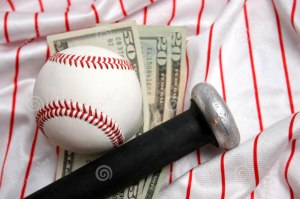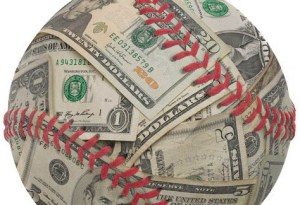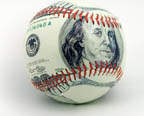In late November of 2016, representatives of Major League Baseball were engaged in tense and critically important labor negotiations with the Major League Baseball Players Association (MLBPA).

And the clock was ticking.
The previous labor agreement was set to expire on December 1st and it was expected that failure to reach an agreement could lead Baseball Commissioner Rob Manfred to declare an immediate lockout of the players.
Which could then lead to cancelling Spring Training and the very real threat that the 2017 baseball season might be in jeopardy.
Fresh in the minds of Commissioner Manfred and Players Association President Tony Clark was baseball’s disastrous 1994 work stoppage, which was a textbook negotiations failure that ended up being extremely costly to both sides.
How to Flunk Your Most Important History Lesson
The early 1990s was an era of increasing union/management acrimony in baseball. Revenues were stagnant and player salaries were rising every year.
Team owners were demanding that baseball adopt revenue-controlling rules such as setting a hard salary cap and ending player salary arbitration. When they insisted those proposals had to be part of the new CBA, communications between both sides quickly deteriorated.
When the then-current CBA expired on December 31, 1993, there was nothing to replace it. Then several months later the stuff really hit the fan when the owners refused to pay $7.8 million owed to the players’ pension plan per the expired labor agreement.

With no negotiations scheduled (or apparently wanted) by either side, the deadline came and the MLBPA led by President Donald Fehr declared a strike.
On August 12th every baseball player on every team walked off the job. The rest of the 1994 baseball season was cancelled, including the postseason and the World Series.
As the strike dragged on for months, the owners played classic hardball by preparing to open the 1995 season with “replacement” players and umpires at every ballpark. That’s when things went from totally crazy to epically insane.
A number of baseball managers and coaches refused to manage the strike-breaking replacement players. The Baltimore Orioles refused to use any replacement players. In Toronto, the Ontario Labour Board declared that replacement umpires would be banned from working Blue Jays home games.
Even after the players voted on March 28th to suspend the strike, baseball owners refused to recognize them and insisted on moving forward with replacement players and umpires.
It took future Supreme Court Justice Sonia Sotomayor, then judge of the United States District Court for the Southern District of New York, to issue a preliminary injunction against the owners on March 31st before regular games finally returned on April 2, 1995.
The calamitous 1994-95 players’ strike lasted 232 days, with a total 948 baseball games cancelled. It is estimated that over $800 million in television deals, postseason revenue, stadium revenue, and player salaries was lost by both sides.
More importantly for the future of the game, baseball fans around the country were equally disgusted with baseball owners and the players union for killing the game.
Happy Days Are Here Again? Not so Fast.
Flash forward to 2016. With Major League Baseball a business now worth $10 billion a year, it was clear that a repeat of the 1994 labor fiasco was simply not going to be allowed to happen.
Commissioner Rob Manfred and players union President Tony Clark announced the signing of the new CBA on November 30, 2016, just four hours before the old CBA was set to expire.
While ESPN reported at the time that there had been “no lightning rod issues” between the two sides, in 2018 we are experiencing the unintended consequences of several key components of that agreement.
And all of a sudden, things are starting to get ugly again.

And the players got several key gains, including that teams signing free agent players no longer had to lose a Rule 4 draft pick.
The difference between the current CBT and a hard salary cap is that a salary cap prohibits teams from going over a certain total salary amount. The CBT allows teams to go past the luxury tax line, but penalizes them if they do.
Now what we’re seeing is that the CBT can still effectively work as a salary cap if the owners will it to be that. As a result, in 2018 the luxury tax is being used as a virtual firewall between wealthy baseball owners and their penchant for spending millions on the free agent market.
This off-season, high revenue teams like the New York Yankees, the Los Angeles Dodgers, and San Francisco Giants have been freely dumping salary to stay under the $197 million CBT limit.
The Major League Baseball Players Association has also seen those three huge market franchises step back from their normal unfettered spending on free agent players.
All of which means that the average player salary isn’t necessarily increasing at the same rate as the increases in team revenue.
There are several reasons that suggest why the 2017-18 free agent market continues to be historically sluggish.
- Teams are “saving up” for the unusual bounty of high end free agents available next off season (led by Bryce Harper, potentially Clayton Kershaw, Jose Altuve, Craig Kimbrel, and Manny Machado);
– - They’re avoiding the increasingly onerous tax penalties that can accrue for repeat luxury tax offenders; and,
– - Maybe most compelling, advanced analytic studies have demonstrated that the majority of player contracts that are for more than five years, and over $100 million, rarely work out for the teams involved.
Follow the Huge Bundles of Money
All of which leads us back to the core issue in all of this: money. And how it gets divided up between baseball owners and baseball players.
For example, in the next several months, every Major League team will receive a check for an estimated $50-$60 million from Major League Baseball. That’s a total of $1.5 – $2 billion.
Those checks represent each team’s take from one event: the Disney Corporation’s 2017 majority stake acquisition of MLB’s BAMTech video streaming and tech services company. An independent company created by MLB, with team owners as the principal investors, BAMTech exemplifies the increasing economic opportunities now available to team ownership groups.
The BAMTech windfall also clearly illustrates the real primary revenue sources for each Major League team: national and local TV and radio contracts, video streaming services, MLB-owned business services, and revenue sharing from the Commissioner’s office.
Twelve MLB teams now have television revenue deals in the billions of dollars.

So the current CBA is a five-year labor agreement, expiring in November of 2021.
Looking forward, it’s very hard to imagine that the baseball owners would agree to eliminate the Competitive Balance Tax. This is the dam holding the wealthiest teams back from flooding baseball’s free market with cascades of money.
The real time result of that is a growing discontent in the MLBPA with the effects of the CBT.
The free agent market has never been slower, which potentially drives down free agent prices. Baseball owners are making more money and at the same time trying to keep more money. MLBPA President Tony Clark is being perceived as not strong enough to face down the owners, and allowing the CBT to damage free agency.
Forbes.com reports that Major League Baseball reached the $10.5 billion revenue range in 2017. In four years that could easily grow to $12 billion.
Which means the stakes will be higher than ever for the players, for baseball owners, and for baseball fans when it’s time to hammer out the MLB 2022 Collective Bargaining Agreement.
Add The Sports Daily to your Google News Feed!
